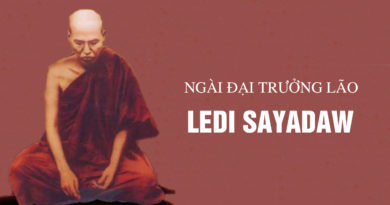THE PATTHANUDDESA DIPANI – CHAPTER 15: AHARA-PACCAYA
THE PATTHANUDDESA DIPANI – CHAPTER 15: AHARA-PACCAYA
The relation of food is of two kinds: material and immaterial. Of these, material food connotes the nutritive essence (or what is called edible food), which again is subdivided into two kinds: internal and external.
All the natural qualities born of the Four Causes, [1] pertaining to those creatures that live on edible food, are here the paccayuppanna-Dhammas related to the two kinds of material food.
As to immaterial food, it is of three different kinds: contact, volitional activity of mind, and consciousness. These kinds of immaterial food, or paccaya Dhammas are causally related to the coexistent properties, both mental and material, which are their corresponding paccayuppanna-dhamma.
In what sense is ahara to be understood? Ahara is to be understood in the sense of ‘holding up strongly’, which means “causing to exist firmly”. That is to say, a relating thing nourishes its related thing so as to enable it to endure long, to develop, to flourish, and to thrive, by means of support. Though the causal relation of food possesses a producing power, the power of support is predominant here.
Here, the two material foods are called ahara, because they strongly hold up the group of internal material qualities born of the Four Causes, by nourishing them so that they may exist firmly, endure long, and reach un-curtailed the bounds (or limits) of their life-term.
Contact is an ahara also, because it strongly holds up its coexistent things, and enables them to stand firmly and endure long by nourishing them with the essence extracted from desirable and undesirable objects. Volitional activity of mind, or (in a word) will, is an ahara in that it furnishes courage for the execution of deeds, words, and thoughts. And consciousness is an ahara also, inasmuch as it predominates in all thinking about an object. These three immaterial foods, in supplying nourishment to the coexistent mentals, also affect the coexistent materials.
Ahara here may also be explained after the Suttanta method. Just as birds, ascertaining where their quarters are, fly with their wings through the air from tree to tree and from wood to wood, and peck at fruits with their beaks, thus sustaining themselves through their whole life, so also beings–with the six classes of consciousness, ascertaining objects; with the six kinds of volitional activity of mind, persevering to get something as an object; and with the six kinds of contact, making the essence of objects appear–either enjoy pleasure or suffer pain. Or, solely with the six classes of consciousness, comprehending objects, they avail themselves of forming, or becoming, body and mind. Or, solely with the contacts, making objects appear in order that feelings may be aroused through the same, they cultivate craving. Or, committing various kinds of deeds through craving accompanied by volitions, they migrate (so to speak) from existence to existence. Thus should be understood how extensive the functioning of the different foods is.
[End of the Ahara-Relation]
FOOTNOTES AND REFERENCES:
[1]: The Four Causes are (1) kamma, (2) citta (consciousness), (3) utu (temperature) and (4) ahara (nutriment).









